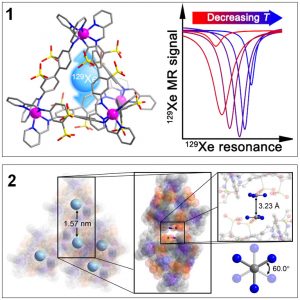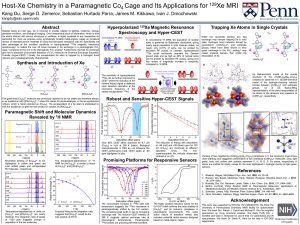 This collaboration between Dmochowski (Seed) and Kikkawa (IRG-3) addresses a major challenge for molecular imaging with conventional MRI: the probes typically have low sensitivity and lack of responsiveness to local environment. The team developed a Co4 129Xe MRI sensor, which takes advantage of the high sensitivity of hyperpolarized 129Xe (~104 times greater signal than conventional MRI), and also has a very temperature-responsive 129Xe chemical shift. Thus, the Co4 sensor is a promising MRI thermometer (see Figure 1).
This collaboration between Dmochowski (Seed) and Kikkawa (IRG-3) addresses a major challenge for molecular imaging with conventional MRI: the probes typically have low sensitivity and lack of responsiveness to local environment. The team developed a Co4 129Xe MRI sensor, which takes advantage of the high sensitivity of hyperpolarized 129Xe (~104 times greater signal than conventional MRI), and also has a very temperature-responsive 129Xe chemical shift. Thus, the Co4 sensor is a promising MRI thermometer (see Figure 1).
Additionally, cryogenic separation of noble gases is energy intensive with unmet needs for selective physisorption of Xe under near-ambient conditions. Interestingly, the Co4 crystal lattice was found to be a selective sorbent for Xe over other noble gases (see Figure 2). Thus, the Co4 lattice provides a tunable platform for further optimization for selective Xe separation.
Du, Zemerov, Hurtado Parra, Kikkawa, Dmochowski, Inorg. Chem., March 24, 2020.
This study was carried out through a collaboration between the Dmochowski group in the Chemistry Department and the Kikkawa group in the Physics Department at the University of Pennsylvania.
 An education and outreach highlights were realized by Kang Du, who presented the study at the Chemistry-Biology Interface Summer Retreat (poster) and in an OpenMIC Departmental Seminar (oral) at the University of Pennsylvania; before Covid-19 the work was selected for presentation (poster and oral) at ACS annual meeting in Philadelphia in March.
An education and outreach highlights were realized by Kang Du, who presented the study at the Chemistry-Biology Interface Summer Retreat (poster) and in an OpenMIC Departmental Seminar (oral) at the University of Pennsylvania; before Covid-19 the work was selected for presentation (poster and oral) at ACS annual meeting in Philadelphia in March.
